Setsubun and Otafuku

Pictured above:
Toko-no-ma, 床の間, floor-’s-room; kake-mono, 掛物, hang-thing, ‘Mame-maki’, 豆撒, bean-throw, by Hanabusa I-tchō, 英 一蝶, Calyx One-butterfly (1652 – 1724); L. 6 shaku kane-jaku. Hana-ire, 花入, flower-receptacle, take, 竹, bamboo, ni-jū-giri, 二重切り, two-tier cut, by David Flanagan, Boston; L. 15 sun kane-jaku. Shin-en-rei, 神苑鈴, god-garden-bell, displayed on a plain wood san-bō, 三宝, three-treasures; H. 5.15 sun kane-jaku.
Ro, 炉, hearth; ro-buchi, 炉縁, hearth-frame; ‘Kashiwa-ba Uba-guchi-gama,’ 柏葉姥口釜, Oak-leaf Old woman-mouth-kettle, tetsu, 鉄, iron, diam. 7 sun kane-jaku.
Take dai-su, 竹台子, bamboo support-of; H. 20 sun kane-jaku / 16 sun kujira-jaku. Displayed on the ji-ita, 地板, earth-board; Mizu-sashi, 水指, water-indicate, white porcelain; h. 4 sun kane-jaku; shaku-tate, 杓立, ladle-stand, green glazed Raku-yaki, 楽焼, Pleasure-fired; h. 6 sun kane-jaku; hi-shaku, 柄杓, handle-ladle, take, 竹, bamboo; hi-bashi, 火箸, fire-rods, brass and silver; ken-sui, 建水, build-water; h. 3 sun kane-jaku; futa-oki, 蓋置, lid-place, porcelain cylinder; h. 1.8 sun kane-jaku. Displayed on the ten-ita, 天板, heaven-board; hira-natsume, 平棗, wide-jujube, thin tea container; H. 1.5 sun kujira-jaku. Kō-gō, 香合, incense-gather, ceramic masks of O-ta-fuku, お多福, O-much-fortune, and an oni, 鬼, demon, Raku-yaki, 楽焼, Pleasure-fired. Ha-bōki, 羽箒, feather-brush, feathers from the left wing of a fukurō, 梟, owl. Their name comes from the call made by some Japanese owls.
![]()
The tokonoma at times may represent a cave, and is called a hora-doko, 洞床, cave-bed, such as at Rikyū’s Tai-an, 待庵, Wait-hut. For the New Year, a kake-mono. 掛物, hang-thing, of the hi-no-de, 日の出, sun-’s-out, the rising sun may be likened to Amaterasu emerging from the Amenoiwato. For Setsubun, an Otafuku kōgo is most often displayed in the tokonoma, while for the New Year, several other types of kō-gō, 香合, incense-gather, are displayed. The image of the rising sun may be replaced by a hanging scroll with the name of Amaterasu written on it.
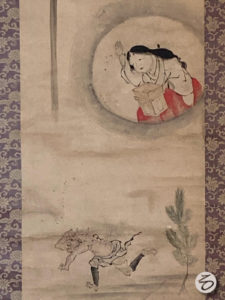
In the pictured hanging scroll, Otafuku holds a Shintō offering stand, san–bō, 三宝, Three-treasure, which supports a masu, 枡, box measure, filled with fuku-mame, 福豆, fortune-beans. She throws them at the oni who is running away. Note the young pine tree that is revealing its roots, which is emblematic of the New Year.

The ornament is composed of a go-hei, 御幣, hon.-cash; two con-joined shide, 四手, four-hand, paper pendants cut from a single sheet of paper, and is closest to the scroll. This is believed in Shintō to symbolically represent the human backbone.
Mizu-hiki, 水引, water-draw, silver and white stiff threads of the five basic colors, are tied in a loop to represent the mirror of Amaterasu. Two stalks of ine, 稲, rice, symbolize hoping for an abundant rice crop: ine is wordplay on year. Mizu-hiki made into matsu-eda, 松枝, pine-branch. Wooden plaque with calligraphy, gei-shun, 迎春, come-spring. Suzu, 鈴, bell.
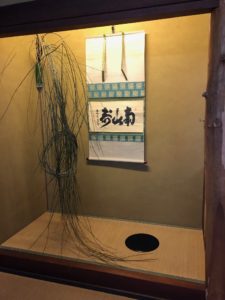
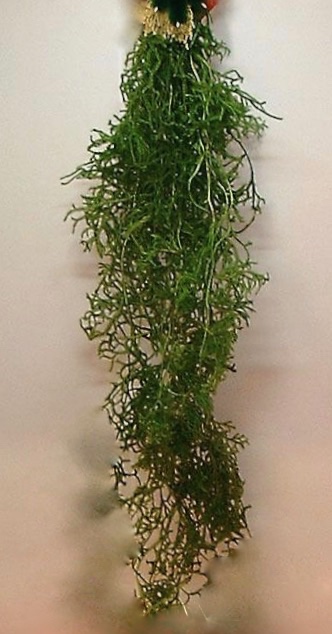
When Amenouzume danced in front of the Ame-no-iwa-to, she wrapped kami-dasuki, 神襷, god-sash, around herself to hold back her sleeves.The assembled gods uprooted the ma-sakaki, 真榊, true-cleyera, a tree related to camellia and tea, and hung various things from its branches. On the upper branches they affixed long strings of myriad maga-tama, 勾玉, curved-beads; in the middle branches they hung a ya-ta kagami, 八咫鏡, eight-span mirror, and on the lower branches they suspended cloths. The Kanji for mirror, 鏡, is composed of the Kanji for metal, 金, and end, 竟, which itself is composed of sound, 音, and man, 儿.
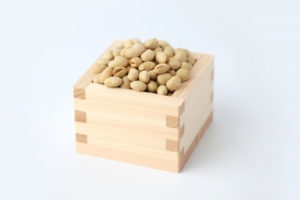
Fuku-mame are roasted soy beans that are thrown at demons during the festival of Setsu-bun, 節分, Season-divide, the last day of winter, usually held on February 2 or 3. Soy beans are called dai-zu, 大豆, large-bean. The event is a symbolic planting ritual, sowing seeds. Dried soy beans are pan-roasted until the skin is slightly cracked. The beans are then called fuku-mame, and are put into a fuku-masu, 福枡, fortune-measure, a wooden box measure.
Traditionally, a man who was born in the current Zodaic year wears a mask of Otafuku, and throws fuku-mame at a person who wears a mask of an oni, 鬼, demon, or someone dressed as an oni. This rite is to dispel the harshness of winter. It is curious to note that the Kanji for oni, 鬼, appears to be composed of the Kanji for ricefield, although the Kanji origin is in doubt.
Setsubun is the eve of Ri-sshun, 立春, Start-spring, when, in the past, everyone observed their birthday happening in the coming year. To help ensure good health, a person should eat one fuku-mame for each year of their present age, plus one for the age they will attain in the coming year. Age is calculated in Japan differently from the west. When a person is born, he or she is one year old, counting the time in the womb. A person who is born on Setsubun, is two years old on Risshun. Imagine that. Because most of Japan has, more or less, adopted some western customs, many people now celebrate their birthday on the day they were born.
The scene in the scroll above is enacted each year on Setsu-bun, 節分, Season-divide, which occurs on February 2nd or 3rd, the ideological last day of winter. Otafuku represents the abundance and fertility of spring dispelling the harshness of winter. The oni is not evil, but embodies aspects of nature that can bring destruction. Setsubun corresponds with Groundhog Day in the west. February 2 or 3 is halfway between the winter solstice, Tō-ji, 冬至, Winter-attain, and the spring equinox, Shun-bun, 春分, Spring-divide. In Japan and elsewhere in the east, the four seasons are about one month and a half ahead of the west.
At one’s home, a person acting as the man-of-the-year, takes the Fuku beans from the masu box on left hand chest high, and goes around each room from the entrance. At the doorway, one scatters beans while repeatedly calling out “Oni wa soto Fuku wa uchi,” 鬼は外福は内, Demon out Fortune in, which is done twice. The correct way to sprinkle is to hold the masu on your left hand at chest height and throw them with your right hand. Close doors and windows, so that evil does not re-enter the house. People eat other roasted beans, certainly not the beans that were throw, one for each year of life, called toshi-tori-mame, 年取り豆, age-take-beans, plus one, to grow on. The soy beans are roasted so that they don’t sprout.
There is a theory that the reason why soy beans were planted was that their yield was the highest among the five grains, and the sound of the beans hitting the ground, and the size of the beans, when driving away the demons had some significance, but it is not clear. Some say that throwing the beans is to blind the oni. In some rites, the oni is a symbol of learning and intelligence, and people dressed up as oni, use a big club to lightly bomp little kids on the head to improve their learning.
The exact origin of throwing beans to dispel bad influences is obscure. After years of delving into Japan’s ancient past, with an eye toward beliefs, there may be a connection with the Shintō gods. It was written in ancient records that the gods chewed a sword or, more commonly, the maga-tama, 勾玉, bent-gems. Amaterasu and her brother Susano-o would put magatama into their mouths, chew them, and blow out bits and pieces that were transformed in gods or other objects or phenomenon. Susanoo would chew up magatama and spit them out of this moth to create lightning bolts and hail scattering them upon the earth and in heaven. It is a popular belief that a magatama resembles a human embryo.

Features of the oni include two rather angular horns and chin, which provide stability, and three is the symbolic number for fire. Fire has no substantial form, but is given the most stable geometric shape of the triangle. The pyramid is the most stable form – a tetrahedron, four faces, and the etymology of ‘pyramid’ is from the Greek meaning ‘fire in the middle’.
The face of Otafuku has three prominent mounds; her cheeks and forehead. They are complementary to the three angles of the Oni mask, and they are opposite in orientation. One if forward of two. Round is In, receptive, water, and angled is Yō, penetrative, fire.
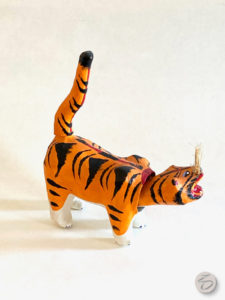
Tigers such as the one pictured left were first created in Kurashiki in 1868, and have been widely copied and are made in a great many sizes from the tiny to the monumental.
Setsu-bun, 節分, Season-divide, occurs annually on February 2nd or 3rd which is the day before Ri-sshun, 立春, Start-spring. Risshun is one of the 24 seasonal divisions of the solar year, it begins Kyū-reki Shō-gatsu Tora, 旧暦正月寅, Old-calendar Correct-moon Tiger. A kakemono of a tiger is often displayed.
Setsubun is a solar calendar event, rather than a lunar calendar event. Setsubun, is ideologically the last day of winter, and many cultural events attempt to dispel the destructive aspects of winter. The harsh aspects of winter are impersonated by an oni, 鬼, demon, and the rejuvenating aspects of spring is impersonated by O-ta-fuku, お多福, O-much-fortune.
Setsubun is the eve of Risshun, and hachi-jū-hachi-ya, 八十八夜, eighty-eighty nights, after Risshun, tea is picked. The date varies from May 1 to May 2. A great moment in the life of Chanoyu. It is an impossibility to pick all the tea on one day, the period of cha-tsumi, 茶摘, tea-pick, begins ten days before, and ten days after hachi-jū-hachi-ya. This period of twenty-one days is the source of the name of mukashi, 昔, past, for certain teas. The Kanji for mukashi, 昔, is composed of the Kanji for twenty, 廿, which is two tens, 十十, one, 一, and sun, day, 日, which is the number of days for picking tea. The first tea ‘name’ was ‘Hatsu-mukashi’, 初昔, first-past, actually means the early part of the twenty-one days, and is better.
The number eighty-eight in Japanese, 八十八, can be written as the Kanji for kome, 米, rice, which is symbolic of Infinity in Space in all directions. The Kanji for tea, cha, 茶, can be written with the Kanji 八十八, and the Kanji for twenty, 廿, which is two tens, 十十. These two Kanji for ten when written together resemble the grass radical, 艹. The sum of the numbers is one-hundred eight, hyaku-hachi, 百八, which is a highly significant number including the number of human desires that should be dispelled. On New Year’s Eve, a temple bell is struck one hundred and eight times to help rid the Hyaku-hachi Bon-nō, 百八煩悩, Hundred-eight Trouble-distress. The Kanji for tea, 茶, with the grass radical, 艹, and 88 as 米, may be understood to mean tea is the plant at the center of the world.
Setsubun began with one of the most important moments in the history of Japan, with ramifications that may extend to the world. This occurred when Ama-terasu Ō-kami, 天照大神, Heaven-brightener Great-god, outraged by the appalling and destructive behavior and actions of her younger brother, Su-sa no o no Mikoto, 素戔嗚尊, Elemental-revered-cry Lord, entered the Ame-no-iwa-to, 天の岩戸, Heaven-’s-rock-door. This was along the Ama-no-kawa, 天の川, Heaven-’s-river, the Milky Way. Upon entering the cave, she sealed the entrance with a great stone, the rock door which no one could move. Thus, the world was plunged into darkness.
In the realm of Chanoyu, the toko-no-ma, 床の間, floor/bed-’s-room, is in many ways similar to a cave. Rikyū’s Tea hut, Tai-an, 待庵, Wait-hut, has a tokonoma with sand-finished walls that extend upward unbroken to the sand-finished ceiling, and is called hora-doko, 洞床, cave-floor. A ceiling in Japanese is called ten-jō,天井, heaven-well. The tokonoma of a Tearoom did not have a window in it, but it is thought that Furu-ta Ori-be,古田織部, Old-ricefield Weave-guild, was the first to put a window in the out wall of the tokonoma. It may be that the true tokonoma should not have much illumination, certainly not an electric light.
Amaterasu and her brother Tsuki-yomi no Mikoto, 月読命, Moon-read’s Lord, were born from the eyes of I-za-na-gi no Mikoto, 伊邪那岐命, That-wicked-what-branch’s Lord. After leaving the underworld to rescue is wife I-za-na-mi no Mikoto, 伊邪那美命, That-wicked-what-beauty’s Lady, he bathed in a pool of water nearby. Amaterasu was born from his left eye, and Tsukiyomi was born from his right eye, and they were given dominion over the heavens as the sun and the moon. Their other brother Susa no mikoto was born from the Izanagi’s nose, and was given dominion over the sea. It is most interesting to note that the sun and the moon were born of water. To better understand their orientation is to envision Izanagi in the north, the seat of deity likened to Polaris, the north star. To his left is the east, the source of the rising sun, Amaterasu, and to his right is where sets the moon, Tsukiyomi.
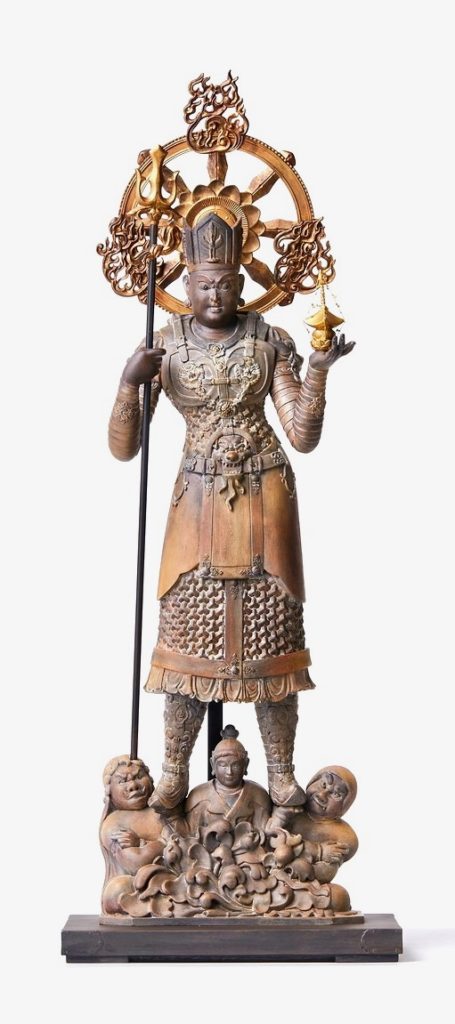
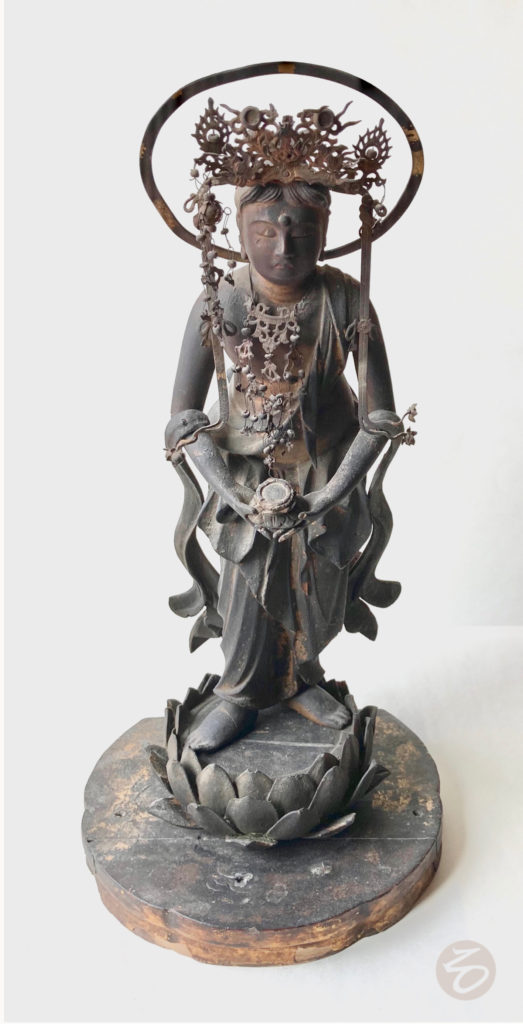
Bishamonten is the Buddhist guardian of the north, and Kannon is the guardian of the north, the zodiac sign of Rat, and midnight. The ancient statue shows him holding on the palm of his left hand a small go-rin-tō, 五輪塔, five-ring-tower, reliquary of the Buddha, and standing on the palms of the central figure that is symbolic of the earth. The figure of Kannon is holding a lotus flower on her palms, upon which one is reborn in Buddhist paradise, and standing on a lotus flower.
The Buddhist temple Kura-ma-dera, 鞍馬寺, , Saddle-horse-temple, is the principle protector of the ancient capital of Hei-an-kyō, 平安京, Level-peace-capital. The main deities of worship are Sen-ju-kan-non, 千手観音, Thousand-hand-see-sound, and Bi-sha-mon-ten, 毘沙門天, Help-sand-gate-king. Both are located in the north, and as such are protectors of the cha-shitsu, 茶室, tea-room. Bishamonten is the leader of the Shi-ten-nō, 四天王, Four-heaven-kings, and is one of the Shichi Fuku-jin, 七福神, Seven Fortune-gods. Pictures of the seven gods aboard the takara-bune, 宝船, fortune-boat, often show Bishamonten in the middle and above the others, although he is not identified as their leader. Such paper pictures are put under one’s pillow on the second night of the new year to influence having an auspicious dream, hatsu-yume, 初夢, first dream. The best three dreams are ‘ichi fuji ni taka san nasubi’, 一富士二鷹三茄子, Mt. Fuji, two hawks, and three eggplants. New Year’s Eve midnight is a sleep deprived time, so the first dream is on the night of the 2nd or 3rd. The north is equal to Tō-ji, 冬至, Winter-attain, the winter solstice, and the return of the Yō, positive aspect of nature. Kannon Bishamonten begin a kind of new year. Images of the Shichi-fukujin are displayed for the established calendar New Year, Shō-gatsu, 正月, True-month.
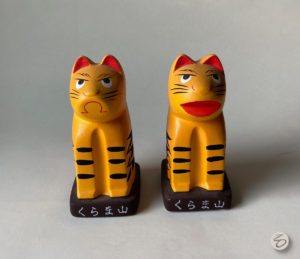
The guardian tigers are souvenirs from Kura-ma–dera, 鞍馬寺, Saddle-horse-temple, north of Kyōto. As guardians of the temple, the tiger with its mouth open, AH, is on the right side of the entrance gate of the temple. The sound AH-UM is the Sanskrit source of all sounds and of completeness. The tiger with its mouth closed denoting HM, is on the left side. It is interesting to note the closed mouth of the tiger is an omega, Ω, borrowed from the Greek alphabet, beginning and end. The current year is a Tora-doshi, 寅年, Tiger-year.
Setsubun is the eve of Risshun, the start of spring, and in the orientation of the yo-jō-han, 四畳半, four-mat-half, Risshun is identified with the northeast corner of the room. This is halfway between the winter solstice / north, and the spring equinox / east. The northeast direction is called the ki-mon, 鬼門, demon-gate. Otafuku’s nemesis is an oni, 鬼, demon. This could be the oni of the demon gate. According to the orientation of Rikyū’s yojōhan, the post in the northeast corner of the Tearoom is also a post of the adjoining tokonoma. The tokonoma is located in the northeast direction of the room to ‘protect’ against the force of nature symbolized by the demon of the demon gate in the northeast.
The position of the teishu when preparing Tea is called i-mae, 居前, be-fore. The most formal orientation of the teishu when preparing Tea is to face north, toward deity who is located in the north. This is likely due to the unmoving north star, Polaris, Ho-kkyoku-sei, 北極星, North-extreme-star. Turning away from the north, the orientation becomes less formal the further away one turns. Presenting Tea with the ro causes the teishu to turn from the north. When preparing Tea with the ro, there are five orientations for imae: facing the ro directly; uchi-zumi, 内隅, inner-corner of the ro frame; soto-zumi, 外隅, outer-corner of the ro; ‘gyō’, 行, transition, is directed 10 tatami me, 目, eye, from the corner of the ro frame; shin, 真, true, is directed 18 tatami me from the corner of the ro frame.
The teishu imae is not just simply directed toward the near places, but locations in the yo-jō-han, 四畳半, four-mat-half, itself. Uchi-zumi, inner corner, is directed 7 sun kane-jaku from the northeast corner post toward the south.
According to the jū-ni-shi, 十二支, ten-two-branches, of the Asian zodiac, the northeast direction combines two signs Ushi and Tora, 丑寅, Ox Tiger. These are animal signs are combined to create the Kanji, Ushi-Tora, 艮, Ox-Tiger. This Kanji, 艮, is also read kon, and as part of the Eki-kyō, 易経, Change-sutra, is symbolic of Mountain. In Taoist symbolism, a mountain in the northeast protects again the harsh winds and possible destruction.
The ancient city of Kyōto was to have been protected by the great mountain of Hi-ei-zan, 比叡山, Compare-intelligence-mountain, and En-ryaku-ji, 延暦寺, Prolong-calendar-temple, but to no avail, as the monks of the temple were a scourge on the city. They were the ‘demons’ of the Kimon, Demon Gate.
The Buddhist guardian of the northeast is Ko-kū-zō Bo-satsu, 虚空蔵菩薩, Empty-space-keep Sacred tree-buddha, who also may be the protector of the kimon? West of Kyōto, in Arashi-yama, 嵐山, Storm-mountain, is Hō-rin-ji, 法輪寺, Law-wheel-temple, that is dedicated to Kokūzō, who is the great protector of women, and girls reaching the age of thirteen.
The exact geographical location of the Ame-no-iwa-to, 天の岩戸, Heaven’s Rock-door, is highly debated, in spite of the declarations around Japan. Taka-chi-ho–kyō, 高千穂峡, High-thousand-sheaf-gorge, Miya-zaki, 宮崎, Palace-cape, Kyū-shū, 九州, Nine-state, is a major possibility as the first site identified as the site.
Near Hōrinji, is the important Shintō shrine, Matsu-no-o Taisha, 松尾大社, Pine-tail Great-shrine, famed for its sacred water, which was founded in 701. The deities of the shrine are O-yama Gui-no-kami, 大山咋神, Great-mountain Drink-god, the god of brewing sake and, of Matsu-o-san, 松尾山, Pine-tail, mountain, the mountain behind the shrine; and I-ki-shima-hime-no-mikoto, 市杵島姫命, City-pestle-island-princess ’s Lady, a female deity protecting travelers.
Naga-oka-kyō, 長岡京, Long-hill-capital, south west of Kyōto, was founded in 784, and Matsuo Taisha may have been the reason that the capital was located there, as the shrine is due north of the Nagaoka area.

The figure is standing on a piece of charcoal, wa-dō, 輪胴, ring-body, that is put into the ro when rebuilding the charcoal fire, go-zumi, 後炭, latter-charcoal. It is the widest piece of charcoal in the fire. Note her necklace with maga-tama, 勾玉, curved-gems, which will also be gifts to Amaterasu.
For the New Year at Urasenke, charcoal is displayed in the Tearoom hoping that it will be blessed for the fires in the coming year: sumi kazari, 炭飾り, charcoal-display. Usually, three large dō-zumi, 胴炭, body-charcoal, are placed on a maru-san-bō, 丸三宝, round-three-treasures, display stand.
The reason that the figure of Uzume is placed on the piece of wadō charcoal, is to emulate her dance on the overturned sake tub. Opening the saka-dawara, 酒樽, sake-barrel, is called kagami-biraki, 鏡開き, mirror-open. Breaking open the mochi that was displayed for the New Year, is also called kagami-biraki. In a way, Uzume’s dance is on the mirror of Amaterasu. The mochi is broken with a mallet on the 11th day of the first month.
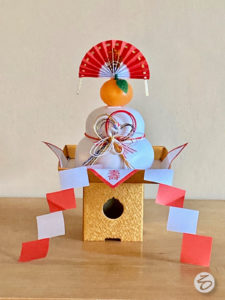
After some research, it was learned that in the year 708, copper was found near the place where Edō would be established. Copper, akagane, 銅, is rather weak, but with tin it is essential in making bronze. Copper had been imported, so with its discovery, Japan could make its own swords, bells, and mirrors. So important was this discovery, that the empress, Gen-mei Ten-nō, 元明天皇, Origin-light Heaven-king, named her reign, Wa-dō, 和銅, Japan-copper. Opening the cave, opening the barrel of sake that like a mirror reflected the light of Amaterasu, this is kagami-biraki, 鏡開, mirror-opening. Copper coins were struck for the first time in Japan, under her rule with the name Wadō imprinted on them. The piece of charcoal, round like a coin, like a mirror, is called a wadō.
The eighty myriads of Shintō gods assembled to coax Amaterasu out of the cave, and return her life-giving light to the world. Ame-no-uzume no Mikoto, 天之鈿女の命, Heaven’s Narrow-woman’s- Lord, danced before the cave’s rock door, on an over-turned sake barrel.
The main occurrence of Setsubun, was a dance performed in front of the Cave of Heaven. Amenouzume opened her garments, revealing her gender, tied her sleeves back, and waved grasses, turning round and round singing what was to become a kind of alphabet. The multitude of gods laughed aloud. Curious, Amaterasu moved back the stone to see what was happening, and her bright rays shone forth. Ama-ta-jikara-o, 天手力男命, Heaven-hand-strength-boy-lord, grabbed the stone and held it fast. To appease Amaterasu, the gods offered her a mirror, a sword, and curved gems, which became the sacred San-shu Jin-gi, 三種の神器, Three-kind’s God-things, that bestow power to the emperors who are descendants of Amaterasu, the Sun Goddess.
Ya-sa-ka-ni no maga-tama, 八尺瓊勾玉, Eight-span jade ’s bent-gem. The offering to Amaterasu was a necklace of five hundred gems. The number five hundred is not precise, but implies many, many. According to the Japanese Kanji 瓊 the color of the jade was red, however, the gem is usually given as being green.

The cluster of bells is shaken at Shintō shrines to bless people: the shaken bells emulate Amenouzume shaking the reeds at the Amenoiwato. The Kanji rei, 鈴, is also read suzu, a common word for small bells. The red and white cords manifest the concept of kō-haku, 紅白, red-white, which is emblematic of the union of In, negative, and Yō, positive.
The three treasures of Shintō are rice, water, and salt. The true ‘shōmen’ of the sanbō is on the opposite side of the stand, as it is facing toward deity in the north. In Chanoyu, the shōmen of objects that have a to-jime, 綴じ目, bind-eye, seam where sides join together, has a mnemonic phrase “maru mae kaku muko,” 丸前角向, round fore corner opposite. The tray of the sanbō is cornered, so that its tojime faces away from deity.
During her dance, Uzume held up various things according to different records. Some say she waved susuki, 芒, eulalia, wrapped around a sword, or ashi, 芦, phragmites, which grow along rivers, a branch of sakaki, 榊, cleyera, etc., even suzu, 鈴, bells, which, perhaps, came much later.
The staff of bells is held in the right hand and twisted left and right, and may suggest the action of the chasen when making tea – the left hand holds the ribbons near their ends. The teishu uses a fuku-sa, 帛紗, cloth-gauze, to purify various utensils, and when not in immediate use is kept tucked into the obi on the left side of the body. The five colors of ribbons of the Shintō bell staff are purple, white, red, yellow, and green. The fukusa used by men is murasaki, 紫, purple, which is a very receptive color, In, to complement his penetrative Yō, and women use a fukusa that is aka, 赤, red, which is a very penetrative color, Yō, to complement her In. The color that is used in the most formal offering of Tea is white. The fukusa may be made of any color.
At a Shintō shrine, when one is blessed by a mi-ko, 巫女, shaman-woman, she twists the cluster of bells over the head as one bows the a little. A miko must be pre- or post-menstrual, because, although blood is sacred, it must not be seen. Most occupations that deal with blood or death, are regarded as outside of civil society.
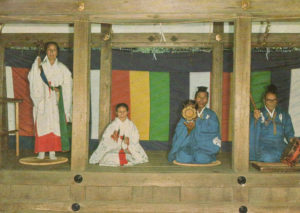
Shin-tō, 神道, God-way, music is called ka-gura, 神楽, god-pleasure, and Ōta Jinja has the oldest kagura in Japan. From the left: a woman dancer miko with shin-rei, 神鈴, god-bells; an older seated lady with te-bira-gane, 手平鉦, hand-flat-gong, cymbals; a middle-aged man with ko–tsutsumi, 小鼓, small-drum, struck with his fingers; and a village elder with a tai-ko, 太鼓, large drum, struck with a stick. To begin, the village elder, calls out to the emperor, hits the drum loudly to start the rite. The music could not be more basic: alternating between the big drum and the bells, and the small drum and the cymbals, to a rhythm of a ticking clock – boom, ching, boom, ching, boom, ching. Thrilling.
From the early days living in Kyōto, I was blessed so many times, by these exceptional and ordinary souls, at monthly evening ceremonies held to ensure that the sun would come up. After the ceremony, the worshippers stand near the woman who twists the bells continuously over one’s head for a few seconds. A sip of o-mi-ki, お神酒, hon.-god-sake, and leave in the dark.
Ō-ta Jin-ja, 太田神社, Great-ricefield God-shrine, founded in 927, was dedicated to Ame-no-uzu-me no Mikoto, 天之鈿女の命, Heaven’s-ornament-woman ’s Lady. Her name is also written, 天宇受賣命, Heaven-sky-turn-show-Lady. Ōta Jinja is a small, ancient shrine in the north part of Kyōto, near Kami-ga-mo Jin-ja, 上賀茂神社, Upper-joy-luxuriant God-shrine. Its ancient, small iris pond is celebrated throughout Japan.
Dancers and entertainers visit Ōta Jinja to ask for blessings in their arts. The dance is emulating Amenouzume’s dance before the cave of heaven when Amaterasu concealed herself from the world. The round seating mats have seven spiral turns that are emblematic of the seven turns on the creation of the world. The spiral, uzu-maki, is an emblem of the mon, crest worn by women of Urasenke. In Chanoyu, there are similar mats, en-za, 円座, round-seat, at the koshi-kake-machi-ai, 腰掛待合, bottom-wait-gather, in the soto ro-ji, 外露地, outer dew-ground. This turning may evoke the turning of Uzume, the turning woman.
Music played at Shintō offerings is called ga-gaku, 雅楽, refined-music, which is an aspect of the imperial court. Shintō shrine music is also called saru–gaku, 猿楽, monkey-music, which is an alteration of san-gaku, 散楽, scatter-music, that came to Japan from China in the 8th century. It could be that Saruta’s name had its origins in monkey music.
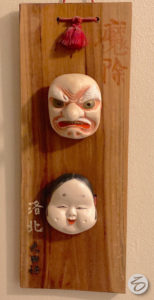
The foremost consort of Amenouzume is Saru-ta-hiko, 猿田彦, Monkey-ricefield-lad, who is also venerated at the shrine. It may be that his name, including ta, ricefield, influenced the name and creation of the woman named Otafuku, connecting her with the ricefield. Her name is often abbreviated to Uzume.
She is joined with Saruta as the chief deities of the Ōta shrines. Union of female and male is essential to the development of rice. Perhaps the source for the original writing of O-ta-fuku, お田福, hon.-rice-fortune is associated with Saru-ta, 猿田, having the same sound of ta.
Other names for Amenouzume, include Uzu-me, 鈿女, Ornament-woman, Oto-me, 乙女, Second-woman, and Oto-go-ze, 乙御前, Second-hon.-fore, the second daughter. O-kame, お亀, Hon.-tortoise. O-ta-fuku, お多福, Hon.-much-fortune, simply O-fuku, お福, Hon.-fortune, Hime-Daruma, 姫だるま, Princess-Daruma.
Male companions: Ame no Ta-jikara-o no Mikoto, 天手力男命, Heaven ‘’s Hand-strong-man ’s lord, Saruta-ko, 猿田彦, Monkey-ricefield-honor, Daru–ma, 達磨, Attain-polish, Hyō-ttoko, 火男, Fire-man, Fuku-suke, 福助, Fortune-assist.
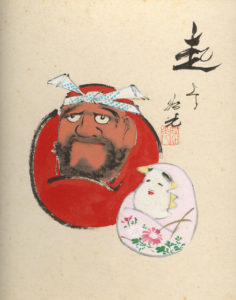
Daruma is the monk who established Zen Buddhism, and is extraordinarily revered in Japan, and she is a manifestation of Ame-no-uzu-me no Mikoto, 天宇受賣命, Heaven-sky-turn-show-Lady. Uzume brought about the rejuvenation of Shintō, causing the return of Amaterasu, the sun goddess. This pair of toys unite Buddhism and Shintō. He wears a worker’s head band, and her kimono has designs of autumn chrysanthemums.
A Daruma doll, when pushed over sits upright is called oki-agari nin-gyō, 起き上がる人形, rise-up person-style. The doll has a weight in the bottom which makes the doll stay up. A person buys a doll, which has blank white eyes, paints in his left eye with ink, makes a wish hoping that Daruma will help make it come true. When the wish does come true, the right eye is painted in. The doll is then offered at a temple to be burned, whether the wish was or was not granted, the flames and smoke rising to heaven. This rite is perhaps the origin of associating Daruma with fire, charcoal, and the Daruma shaped gourd sumi–tori, 炭斗, charcoal-measure.
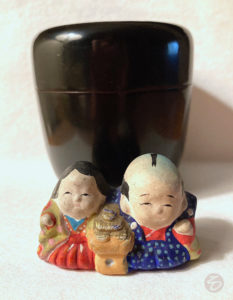
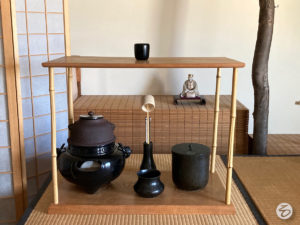
Pictured above: Take dai-su, 竹台子, bamboo support-of; H. 20 sun kane-jaku / 16 sun kujira-jaku. Displayed on the ji-ita, 地板, earth-board; ki-men fu-ro, 鬼面風炉, demon-face wind-hearth, and kama, 釜, kettle. Kara-kane kai-gu, 唐銅皆具, Tang-copper all-tools: shaku-tate, 杓立, ladle-stand, with hi-shaku, 柄杓, handle-ladle, hi-bashi, 火箸, fire-rods; ken-sui, 建水, build-water; mizu-sashi, 水指, water-indicate, within unseen futa-oki, 蓋置, lid-place.
Mizu-sashi, 水指, water-indicate, white porcelain; h. 4 sun kane-jaku; shaku-tate, 杓立, ladle-stand, green glazed Raku-yaki, 楽焼, Pleasure-fired; h. 6 sun kane-jaku; hi-shaku, 柄杓, handle-ladle, take, 竹, bamboo; hi-bashi, 火箸, fire-rods, brass and silver; ken-sui, 建水, build-water; h. 3 sun kane-jaku; futa-oki, 蓋置, lid-place, porcelain cylinder; h. 1.8 sun kane-jaku. Displayed on the ten-ita, 天板, heaven-board; hira-natsume, 平棗, wide-jujube, thin tea container; H. 1.5 sun kujira-jaku.
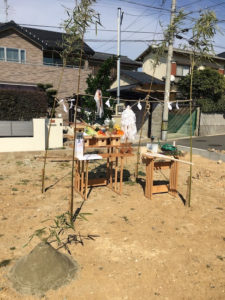
The area is cordoned with four green bamboo stalks at the corners of the cleared ground. Shime-nawa, 注連縄, pour-along-rope, straw rope with shi-de, 四手, four-hand, paper adornments. Offerings are placed on san-bō, 三方, three-treasures, displayed on ha-ssoku-dai, 八足台, eight-leg tables. The four bamboo posts of the jichinsai may be the origin of the essential concept of the take-dai-su, 竹台子, bamboo-support-of. The small conical mound of earth holds the to-chi-no-kami, 土地の神, earth-ground-‘s-god.
Dusting for the New Year is done with long stalks of leafy bamboo, used to flail away dust, which is called sasa–harai, 笹払い, bamboo grass-purify, and susu-harai, 煤払い, dust-purify. The shide are also purifying the area.
Tea gatherings for Setsubun and Hatsu-gama, 初釜, First-kettle, held early in the new year, there may be large groups of people in attendance. The yojōhan was created for an ideal number of four guests. With some effort, three people could sit on a single tatami, so that the maximum number of three guests each of the three of the available tatami would be nine guests. Possible, but not ideal. In Tearooms with eight to twelve tatami, a large number of guests can be comfortably seated. Calculating the amount of tea for a large number of guests, the amount of tea that can be held in a chaire is critical.
Through personal experience, I found that a large chaire can hold enough matcha for twelve guests. The traditional amount of koicha for each guest is one standard tablespoon, so that one might assume that only twelve people can gather at a Tea. No. Additional guests can be served Tea by a teishu’s one or more helpers called han-tō, 半東, half-east.
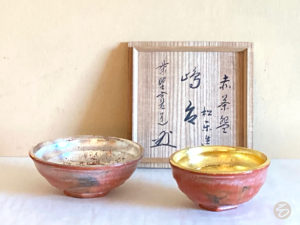
The pair of bowls are stacked one on top of the other in a procedure is called kasane-jawan, 重茶碗, stacked-tea-bowl, and used when serving Tea to a large number of guests in the Tearoom. The name, Shima-dai, refers to the semi-mythical ideal place were live a happily married couple, Uba and Jo, surrounded by auspicious motifs.
Fuji-ta Kan-dō, 藤田寛道, Wisteria-field, abbot of Un-rin-in, 雲林院, Cloud-grove-temple, a sub-temple of Dai-toku-ji, 大徳寺, Great-virtue-temple, which is located in the Murasaki-no, 紫野, Purple-field, area of Kyōto. The name of the area is called purple as it was a place where gromwell plants were grown for the purple dye that was made from its roots. It is thought that Murasaki Shiki-bu, 紫式部, Purple Rite-bureau, author of the Tale of Genji, took her name from having been born in the vicinity.
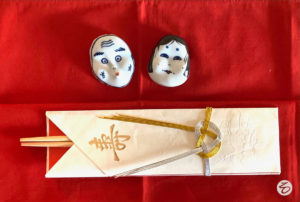
Willow chopsticks are used to eat the New Year’s meal, and then thrown into a river to dispel disease, which then floats along to the Ama-no-kawa, 天の川, Heaven-’s-river, the Milky Way. The musubi yanagi, 結柳, tie-willow, in the tokonoma for the New Year is a river-like connection between earth and heaven. The loop that is tied in the willow may be symbolic of the mirror of Amaterasu, ya-ta kagami, 八咫鏡, eight-span mirror.
Hi-otoko, 火男, Fire-man, also read Hyottoko, blows his breath into a bamboo tube to stoke a fire, hence his puckered mouth. He is also somewhat identified with the octopus, and often in erotic situations with Otafuku. Erotic literature was meant to be instructive more than lurid. Sarutahiko is said to be the great ancestor of Tengu mountain goblins, and some Shintō shrines dedicated to him have fire festivals that also have impersonators of Tengu walking on fire. So, it may be that Hyottoko are manifestations of Sarutahiko.
There are Tea-gatherings where rice is cooked in a cha-meshi-gama, 茶飯釜, tea-rice-kettle, a separate kettle is put over the charcoal in the Tearoom. This usually may take place with the ro, although there are furo that have a rice cooking kettle as well. To make the fire burn hotter, the teishu and perhaps the guest or guests may blow through a hi-fuki-take, 火吹き竹, fire-blow-bamboo, tube to stoke the fire. This procedure is the origin of the puckered mouth of Hyottoko. He may also have origins in an association with Daruma, who also has strong connections with fire rituals and charcoal.
The tub that Uzume over-turned was a shu-sō, 酒槽, sake-barrel, upon which she danced. The incident itself is called uke-fu, 槽伏, tub-overturn. Kanji sō, fune, 槽, tub, is composed of ki, 木, tree, and sō, 曹, official. No Japanese person is going to overturn any container of sake without drinking all of it, let alone that which has been offered to Amaterasu.
For more on Setsubun and Otafuku, see also: Setsubun Extra (article), Setsubun and Risshun (article), Tea in February (article), Setsubun and Otafuku (picture gallery), Setsubun Lecture (video), Setsubun Tea Gathering (video).

